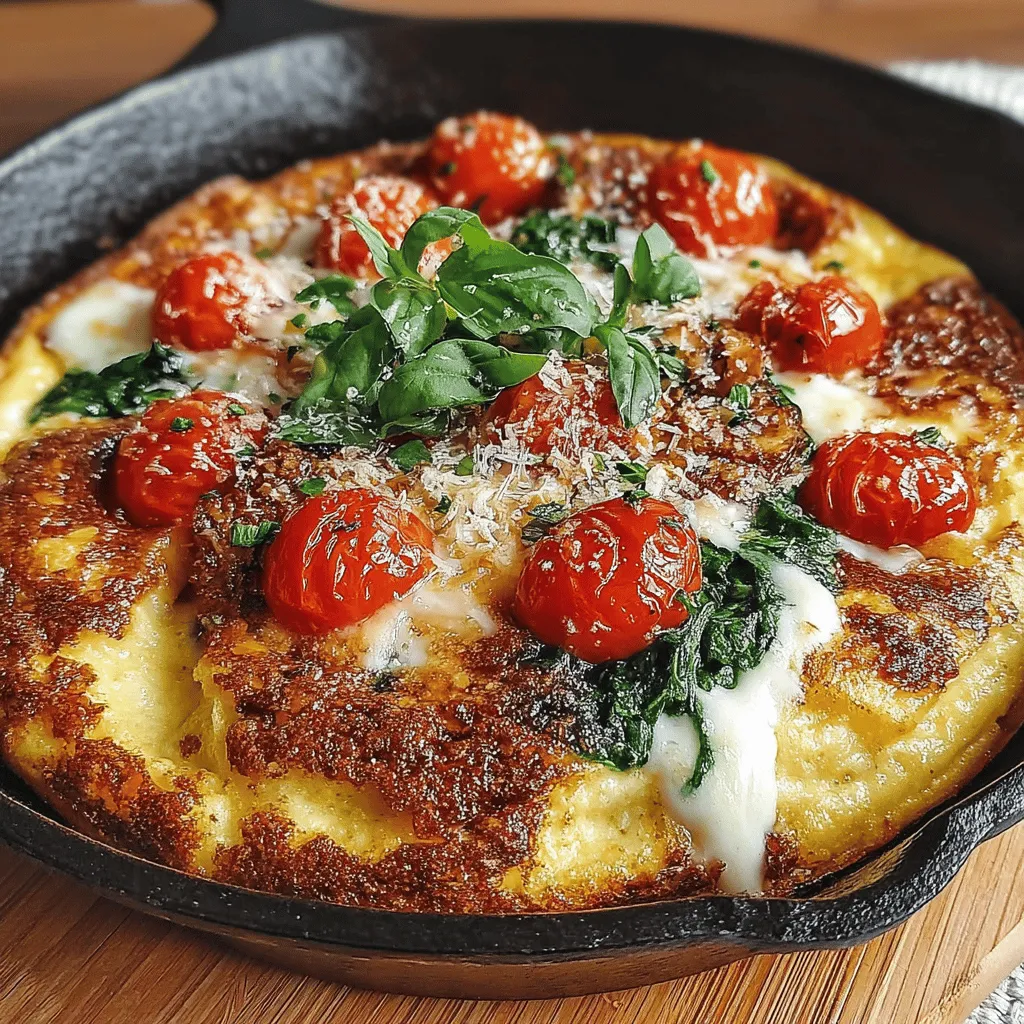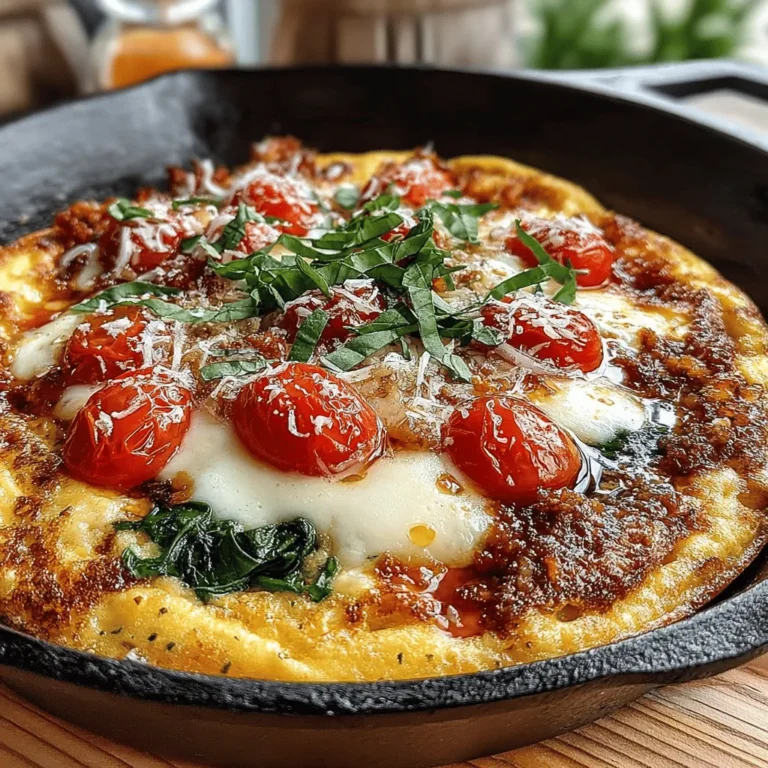Savory Baked Frittata with Tomatoes and Spinach: A Wholesome Meal Option
Frittatas are a beloved dish in many households, celebrated for their versatility and ease of preparation. This Italian-inspired egg dish can be enjoyed any time of day, making it an ideal choice for breakfast, brunch, or even a light dinner. With a blend of fresh ingredients like tomatoes and spinach, a savory baked frittata not only delivers on flavor but also brings a wealth of nutritional benefits to the table.
Incorporating fresh vegetables and herbs into your meals is essential for maintaining a healthy diet. Not only do they enhance the flavor and texture of dishes, but they also provide essential vitamins and minerals that contribute to overall well-being. Our featured recipe—savory baked frittata with tomatoes and spinach—showcases how simple ingredients can come together to create a delicious and satisfying meal. This frittata is an excellent option for those looking to enjoy a nutritious dish that is easy to prepare and full of vibrant flavors.
Understanding Frittatas
At its core, a frittata is an Italian egg-based dish similar to an omelet or quiche, but with distinct characteristics that set it apart. Frittatas are typically cooked slowly over low heat and can be finished in the oven, allowing for a fluffy texture and a golden-brown top. Unlike omelets, which are folded and often served as a single portion, frittatas are usually cooked in a larger pan and cut into wedges for serving. This makes them perfect for sharing and serving a crowd.
One of the most appealing aspects of frittatas is their versatility. You can customize them with a variety of ingredients, making them a wonderful way to use up leftover vegetables, meats, or cheeses. Whether you prefer a classic combination or want to experiment with unique flavors, there’s a frittata that will suit your palate. This flexibility not only allows for culinary creativity but also makes it easy to cater to different dietary preferences, whether you’re looking for a hearty vegetarian option or a protein-packed meal.
Nutritional Benefits of the Key Ingredients
The star ingredients of our savory baked frittata—eggs, spinach, tomatoes, cheese, and garlic—are not only flavorful but also packed with nutritional benefits.
– Eggs: Often considered a superfood, eggs are an excellent source of high-quality protein, containing all nine essential amino acids. They are also rich in vitamins such as B12, riboflavin, and selenium, making them a powerhouse of nutrition that supports muscle health, brain function, and overall vitality.
– Spinach: This leafy green is a nutrition superstar, loaded with iron, vitamins A and K, and antioxidants like lutein and zeaxanthin. Spinach is known for its health benefits, including promoting eye health, supporting bone density, and improving blood circulation.
– Tomatoes: With their vibrant color, tomatoes are not only delicious but also rich in lycopene, a powerful antioxidant that has been linked to reduced risk of chronic diseases. They are also an excellent source of vitamin C, which supports the immune system and skin health.
– Cheese: Adding cheese to your frittata enhances its flavor and creaminess while providing a good source of calcium and protein. The type of cheese you choose can also influence the taste; for example, feta can add a tangy note, while cheddar can provide a sharp flavor.
– Garlic: Renowned for its numerous health benefits, garlic is known to have anti-inflammatory and antimicrobial properties. It adds depth of flavor to the frittata, making it even more enticing.
Ingredient Breakdown
To create a savory baked frittata with tomatoes and spinach, you’ll need the following key ingredients:
1. Eggs: Typically, about 6 to 8 large eggs are used, depending on the size of the frittata you want to make. Eggs can be substituted with egg whites or egg substitutes for a lighter version.
2. Fresh Spinach: Approximately 2 cups of fresh spinach, roughly chopped. If fresh spinach isn’t available, you can use frozen spinach—just be sure to thaw and drain it well to remove excess moisture.
3. Tomatoes: You can use fresh cherry tomatoes, diced Roma tomatoes, or even sun-dried tomatoes for a more intense flavor. About 1 to 2 cups of tomatoes will enhance the frittata’s texture and juiciness.
4. Cheese: A good melting cheese like mozzarella or a tangy option like feta works well. You can use about 1 cup of shredded cheese, but feel free to adjust based on your preference.
5. Garlic: 2 to 3 cloves of garlic, minced, will provide a fragrant base for the frittata.
6. Seasonings: A pinch of salt and pepper, along with optional herbs such as basil or oregano, can enhance the dish’s flavor profile.
7. Olive Oil: For sautéing the vegetables, about 1 tablespoon of olive oil is sufficient. You may also use butter or cooking spray as alternatives.
Step-by-Step Instructions
1. Preheat the Oven: Start by preheating your oven to 375°F (190°C). A properly heated oven is crucial for achieving that perfect golden top on your frittata.
2. Prepare the Vegetables: In a large oven-safe skillet, heat the olive oil over medium heat. Add the minced garlic and sauté for about 30 seconds until fragrant. Next, add the chopped spinach and cook until wilted. If using fresh tomatoes, add them to the skillet and let them soften for a few minutes. Season the mixture with salt and pepper to taste.
3. Whisk the Eggs: In a mixing bowl, crack the eggs and whisk them until well combined. You can add a splash of milk or cream if you want an extra creamy texture. Mix in any additional seasonings or herbs at this stage for added flavor.
4. Combine Ingredients: Once the vegetables are ready, pour the egg mixture over the sautéed spinach and tomatoes in the skillet. Gently stir to ensure that the vegetables are evenly distributed throughout the eggs. Sprinkle your choice of cheese on top.
5. Bake the Frittata: Transfer the skillet to the preheated oven and bake for 20 to 25 minutes or until the frittata is set in the center and lightly browned on the edges. You can check for doneness by inserting a knife into the center; it should come out clean.
In the next section of this article, we will delve into additional tips for serving and storing your savory baked frittata, as well as ideas for variations to make this dish your own. Stay tuned!

Preheat the Oven: Importance of Temperature in Baking
Preheating the oven is a crucial step in the baking process, especially for dishes like frittatas. Setting your oven to the correct temperature—typically 375°F (190°C) for a frittata—ensures that the dish begins cooking evenly from the moment it goes in. An adequately preheated oven allows for optimal heat distribution, which is essential for achieving that fluffy texture you desire. If you skip this step, you risk uneven cooking, which can lead to a frittata that is overcooked on the edges and undercooked in the center. So, be patient; allow your oven to reach the right temperature before sliding in your frittata.
Sautéing Vegetables: Techniques for Enhancing Flavor Through Cooking
Sautéing the vegetables before adding them to your egg mixture is a key technique that can significantly enhance the flavor of your frittata. Start by heating a tablespoon of olive oil in your oven-safe skillet over medium heat. Once the oil is hot, add in the chopped onions. Cook them until they become translucent, about 3-4 minutes. Next, add fresh spinach and diced tomatoes to the skillet. The spinach should wilt down beautifully, absorbing all the rich flavors from the onions.
For added depth, consider seasoning your vegetables with a pinch of salt and pepper while they cook. This not only helps in flavoring the vegetables but also draws out moisture, leading to a better texture in the final frittata. As the vegetables sauté, they create a fragrant base that elevates the entire dish.
Whisking Eggs: Tips for Achieving the Perfect Egg Mixture
Once your vegetables are prepared, it’s time to focus on the eggs. Use a large mixing bowl to whisk together 6 to 8 large eggs. For a frittata with a fluffier texture, add a splash of milk or cream—about 1/4 cup will do. This addition not only enriches the flavor but also helps create a lighter frittata.
When whisking, aim for a uniform mixture that incorporates air into the eggs. This step is vital for achieving that fluffy texture. After whisking, incorporate a handful of shredded cheese—like mozzarella or feta—into the egg mixture. The cheese adds a creamy richness that complements the vegetables beautifully.
Combining Mixtures: Ensuring Even Distribution for Consistent Cooking
With your sautéed vegetables and egg mixture prepared, it’s time to combine them. Pour the egg mixture over the sautéed vegetables in the skillet, making sure it evenly coats all the veggies. Gently stir with a spatula to ensure the vegetables are distributed throughout the egg mixture. This step is crucial for achieving an even cook; you want bites of frittata that are rich in flavor and texture.
Once combined, allow the mixture to sit for a couple of minutes. This allows the flavors to meld, and the eggs will begin to set slightly around the edges. This technique ensures that every slice of your frittata is consistent in flavor and texture.
Baking Process: Achieving the Ideal Texture and Doneness
Transfer your skillet to the preheated oven and let it bake for about 20 to 25 minutes. It’s important to keep an eye on it as baking times can vary depending on your oven and the size of your skillet. The frittata is done when the edges are set and the center is just slightly jiggly. Remember, the frittata will continue to cook a bit after you take it out of the oven due to residual heat.
To test for doneness, insert a knife into the center. If it comes out clean, your frittata is ready. Avoid overbaking, as this can lead to a rubbery texture. The perfect frittata should be soft yet firm and slightly puffed.
Garnishing: Enhancing Presentation and Flavor with Fresh Herbs
Once your frittata has cooled for a couple of minutes, it’s time to enhance its visual appeal and flavor with garnishes. Fresh herbs such as parsley, basil, or chives can add a burst of color and freshness. Simply chop the herbs finely and sprinkle them on top of the frittata before slicing. Additionally, a light drizzle of extra virgin olive oil or a sprinkle of flaky sea salt can elevate the dish’s flavor profile, making it not only delicious but also visually appealing.
Cooking Tips for a Perfect Frittata
Importance of Using an Oven-Safe Skillet
When making a frittata, using an oven-safe skillet is non-negotiable. Cast iron skillets or non-stick skillets are excellent choices, as they can withstand high oven temperatures and help cook the frittata evenly. If you attempt to bake a frittata in a regular frying pan, you might end up with a mess when trying to transfer it to the oven.
How to Tell When the Frittata is Done Baking
To determine if your frittata is perfectly baked, look for the following signs: the edges should be firm and lightly browned, while the center should be set but still slightly jiggly. If you’re unsure, a knife inserted into the center should come out clean. Remember that the frittata will continue to cook from residual heat, so taking it out when it’s just shy of fully set is ideal.
Tips for Avoiding a Rubbery Texture
Overcooking is the main culprit for a rubbery frittata. To avoid this, keep a close watch on your cooking time and take it out when it’s just set. Additionally, using high-quality eggs can make a difference in texture. Fresh eggs tend to yield a creamier frittata, enhancing the overall enjoyment of the meal.
Serving Suggestions
Ideal Pairings: What to Serve Alongside the Frittata
A frittata is versatile and can be served at any meal, but it pairs especially well with fresh, vibrant accompaniments. Consider serving your savory baked frittata with a side salad of mixed greens dressed in a light vinaigrette. This adds a refreshing contrast to the richness of the frittata. For breakfast or brunch, crusty bread or toasted bagels can round out the meal beautifully.
Portion Sizes and Serving Ideas for Different Occasions
For a large gathering, cut the frittata into generous wedges and serve it alongside a variety of brunch staples like fresh fruit, yogurt, or pastries. If you’re serving it as a light dinner, consider smaller portions accompanied by hearty sides like roasted vegetables or a grain salad.
Presentation Tips for Serving Frittatas at Gatherings
To impress your guests, consider garnishing the frittata with additional fresh herbs or a sprinkle of cheese before serving. Plating it on a wooden board or a colorful serving platter can enhance its visual appeal. Offering different hot sauces or salsas on the side allows guests to personalize their servings, adding an interactive element to the meal.
Storage and Reheating
Best Practices for Storing Leftovers
If you have leftover frittata, store it in an airtight container in the refrigerator. It can last up to four days, retaining its flavor and texture when stored correctly. For longer storage, consider freezing individual slices wrapped tightly in plastic wrap followed by aluminum foil. This will help preserve their quality.
How to Properly Reheat Frittata While Maintaining Texture and Flavor
To reheat, preheat your oven to 350°F (175°C). Place the frittata on a baking sheet and cover it with foil to prevent drying out. Heat for about 10 to 15 minutes or until warmed through. Alternatively, you can reheat individual slices in the microwave for 30 to 60 seconds, but be cautious as this can sometimes result in a rubbery texture.
Conclusion
The savory baked frittata with tomatoes and spinach is not only a delicious meal option but also a fantastic way to incorporate fresh vegetables into your diet. Its versatility allows for endless customization, encouraging you to experiment with seasonal ingredients or your favorite flavors. This frittata can be served for breakfast, lunch, or dinner, making it a staple in any household.
We hope this recipe inspires you to gather fresh ingredients and share a meal with loved ones. Cooking is a joyful experience, and there’s nothing quite like presenting a dish that not only looks great but also tastes incredible. So, roll up your sleeves, embrace the art of cooking, and enjoy the satisfaction of creating a beautiful frittata that’s sure to impress!


